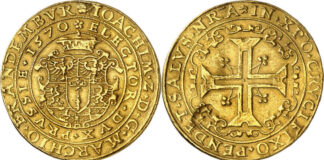The Top Five of Künker’s Fall Auction Sales
The room at Steigenberger Hotel Remarque was crowded – from the beginning to the last day. More than 300 bidders came in person to take part in the auctions. After all, a Künker auction is still a social event with auction dinners and the opportunity to get in touch with fellows from all over the world. Of course, there were also many bidders that participated via phone: up to twelve phones at once during the sale of a single lot! Therefore, it did not come as a surprise that the total estimate of about 7 million euros soared to impressive 11 million.
We present the auction week’s top five results – and as a plus the top five Greek coins, which were particularly interesting this time.
And so in order to prove that collecting coins is a hobby for each and everyone, we will show you an attractive Greek coin for a small budget.
Number 5:
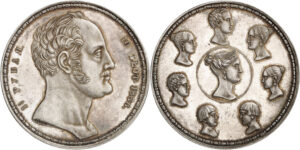
A Russian family rouble of Nicholas I minted in 1836/7 in Saint Petersburg with a mintage of only 150 specimens is ranked 5th with a result of 85,000 euros. This is a relatively low price for this gorgeous piece, which – together with the Bavarian “Geschichtstaler” – marks the beginning of modern commemorative coinage.
Of course, there have been coins commemorating particularly significant events before. But they were used as gifts for an elite circle, presented in the context of ceremonies taking place on special occasions. Ludwig I of Bavaria and Tsar Nicholas I of Russia were the first to use coins in order to foster loyalty among their people and to create a “national” identity. Back then, dynasties like the House of Wittelsbach and the House of Romanov were still considered to be topics suitable to identify with.
Whereas the Bavarian “Geschichtstaler” were minted in huge quantities, the Russian family rouble remained a trial piece. Since it is the only contemporary coin featuring the portrait of the tsar that abolished serfdom in Russia, it is a highlight for every collection of Russian coins.
Number 4:
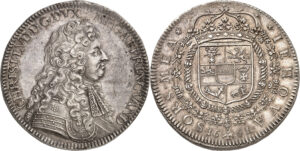
A double reichstaler of Christian Louis I from Mecklenburg already generated a high price at Künker’s Summer Auction 2019. With a hammer price of 80,000 euros, the piece ranked 7th in the sale’s top ten results. However, the result of this broad double reichstaler, which was made under the rule of same prince in 1681, is even higher. That’s no surprise: This double reichstaler is not only extremely rare, impressive and of outstanding quality – there is also a great story about its commissioner, which would be perfect for a novel:
Having financial problems, 26-year-old Christian I married a woman almost 9 years older than him. She contributed a significant dowry to the marriage. Christian snaffled it completely. And when his wife left him in order to force him to surrender the dowry, he instantly divorced her for maliciously abandoning him.
However, he did not succeed in enforcing this divorce in the Holy Roman Empire. Therefore, the Mecklenburg duke went to France, converted to Catholicism, added the name of his godfather Louis XIV to his own and was pleased about the fact that this his godfather made the Sorbonne declare his divorce to be legally sound and the Pope undo the marriage.
Thus, Christian I Louis was free to marry again. This time he chose the pretty widow Isabelle Angélique de Montmorency. She was intelligent enough to demand that a prenuptial agreement be set up. She accompanied her husband to Mecklenburg and, following the elegant custom of the Rococo period, cuckolded him in the most charming way. Christian sent her back to France. But she returned: She won the Welfs as allies as a diplomat in the service of Louis XIV.
The career of his wife Isabelle ended in 1681, the year in which Christian Louis had his double reichstaler minted. She fell ill with smallpox. A pockmarked woman was unsuitable as a charming diplomat. She returned to Paris to collect pieces of art and to marry her nieces to wealthy men.
Number 3:
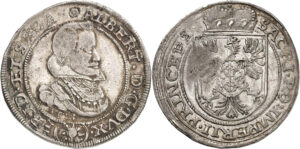
Speaking of wives: We can also tell something interesting about this topic with regard to Albrecht von Wallenstein, whose extremely rare half taler from 1628 climbed from 10,000 to unexpected 120,000 euros and thus made the 3rd place of our top 5: He was lucky with his second wife Isabella von Harrach, who the then 40-year-old married in 1622. She was not only pretty, but also in love with her husband. At least do her letters lead to that conclusion.
However, she was probably not that intelligent. Already one day before (!) the murder of her husband in 1634, she wrote to the emperor that she was entitled to own the properties of Neuschloß, Weißwasser and Hirschberg and that they must immediately be handed over to her. After the murder she demanded that the emperor pay her 300,000 ducats as a one-off payment and annual alimony of 12,000 ducats. Even if the emperor had had the money, he would have probably had better things to do with it than financing the luxurious life of a spoiled young woman. But after all, Isabella was the sister of the archbishop of Prague, Cardinal Ernst Adalbert von Harrach. Therefore, the properties of Neuschloß and Česká Lípa were handed over to her – for Christian mercy (!).
Number 2:
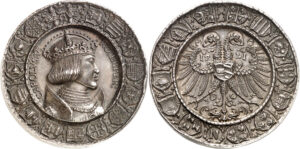
An original of the medal commissioned by the free imperial city of Nuremberg as a gift for the newly elected King Charles V on the occasion of his planned entry into the city of Nuremberg was sold at 260,000 euros. Thus, the piece made the 2nd place of our top 5.
The die was designed by Albrecht Dürer himself; Hans Krafft minted and engraved the piece. At the time, the medal was considered a masterpiece of minting technique due to its impressive weight of about 200 g.
This medal is one of only four originals available on the market – this fact explains the high hammer price. In 1521, 167 specimens of this medal were produced, most of them were melted down later because it turned out that Charles V would not come to Nuremberg after all: Nuremberg had fallen victim to the plague and thus the Imperial Diet took place in Worms instead.
Please do not confuse this specimen with later casts, which are not as rare as the original pieces. After all, the medal was already a sought-after piece of art among collectors of the Baroque period. The prices for the casts are significantly lower. But if one of the original pieces is on offer, the hammer price is accordingly high.
Number 1:
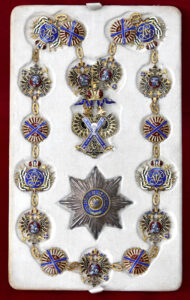
And the winner is… no coin but an order: a set of collars of the Imperial Order of St. Andrew the Apostle the First-Called, sold at a hammer price of 280,000 euros.
This order was established by Peter I and awarded in recognition of merits in the Great Turkish War. Even after the war, it remained the highest order of the Russian Empire and was awarded only rarely. 39 men were honoured by Peter I with this order. Between 1699 and 1917 a total of 1,060 men and women, often from the high nobility, were awarded the order.
Thanks to the hallmark, the production of this order can be dated exactly between 1908 and 1917. Only 47 orders were awarded during this period of time – in most cases the insigne had been returned because the person receiving the honour had died, and now they were awarded again. Therefore, the set of collars sold at 280,000 euros is significantly rarer than insigne of this order from other epochs. We do not know who this piece belonged to, but we can certainly give free rein to our imagination. After all, men and women of the highest social spheres were among the persons honoured with the order – for example the Italian and Portuguese King, the Japanese Emperor Hirohito and Prince Edward, who was to ascend the English throne as Edward VIII before he abdicated in order to marry Wallis Simpson from America.
Greek Coins
Künker’s auction 326 contained a marvellous collection of incredibly beautiful Greek coins, many of them with excellent provenances. Therefore, it did not come as a surprise that dealers and collectors came from all over the world to place their bids and to acquire some of the offered pieces. Accordingly, the prices were quite impressive.
Number 4 (twice):
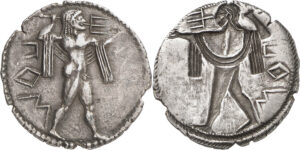

The 4th place of our top five goes to two pieces. Both of them – sold for 30,000 euros each – stem from the archaic Greek period.
But that is the only thing they have in common. Whereas the stater from the Lucanian city of Poseidonia has an exquisite style and a delicate engraving, the heavy octodrachm from the city of Abdera in Thrace convinces due to its impressive simplicity. And there are reasons for these differences. The heavy coins from northern Greece were meant to be exported to the entire Mediterranean in order to serve as standardized trade goods. In order to do so, it was not necessary for the coins to have a splendid and complicated design. Their fate was to be melted down anyway. On the other hand, the stater from Poseidonia was a trading coin that did not only circulate in Poseidonia, but also in other cities like Kroton, Metapontum and Sybaris. All cities minted their coins according to the same weigh standard and by using the same minting technique – what differentiated them was their design. There was probably also a contract laying out the details of the mintage and control procedures as it is known of with regard to another Greek monetary union, the union between Phocaea and Mytilene. In any case, Poseidonia only minted coins on very rare occasions. Therefore, the magnificent Poseidon with his mighty trident is a rarity on incuse coins.
Number 3:
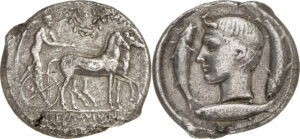
A tetradrachm from Gela with a hammer price of 38,000 euros is ranked 3rd – and that even though its condition had “only” been described as “minimally corroded, very fine”. The reason is the fact that the head of the juvenile river god depicted on the reverse is considered one of the most beautiful ones of Sicilian coinage.
Only very few specimens of this type have been preserved; therefore, the bidder who wanted to acquire this unique work of art for his collection had to make do with “minimally corroded, very fine”.
By the way, if you want to truly understand how amazing the engraver was that created the coin, do not look at the head but at the three fish instead. The vividness expressed by the fish depicted once from below, once from above and once from the side is a top performance – even for one of the talented die cutters from Sicily!
Number 2:

The magnificent head of Heracles depicted on this tetradrachm from Kamarina is almost as rare as the juvenile river god from Gela. The coin was sold for 40,000 euros; thus, it is the piece with the second highest price in the section of Greek coins. Pay attention to the realistic depiction of the man’s head. The face and the beard are shown in so much detail that it almost seems to be a portrait. There is a reason why Greek coins are considered to be the most beautiful coins of the entire monetary history.
Number 1:

It was not only its beauty that made the tetradrachm of Alexander I of Macedonia the winner of our little competition. The victorious bidder was willing to pay 42,000 euros for the piece. He appreciated the archaic simplicity of the goat protomes. The horse’s head on the obverse is a masterpiece, too. Look at the famous Elgin Marbles in the British Museum: You will see heads of horses that look just like this one.
The specimen’s provenance was almost more important than its aesthetic qualities when it came to determining its price. Every coin that has once been part of the Gillet Collection – better known as “Kunstfreund” – generates a significantly higher price than pieces of the same grade made with the same die. The coin’s provenance can be traced back to 1904. And that is why is became the most expensive Greek coin of the entire auction.
Outside the Competition:
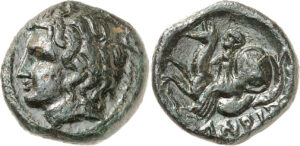
No, you do not have to pay 42,000 euros to acquire a magnificent Greek coin. 60 euros are enough. I want to show you this small bronze from the city of Larissa Cremaste as an example.
In ancient times, Larissa Cremaste was considered the home of the Myrmidons with their black armour and shields. They played a decisive role in the conquest of Troy – and the people of Larissa Cremaste took great pride in that fact. They were so proud that they assumed automatically that the leader of the Myrmidons the great Greek hero Achilles had been born there, too. And thus, Achilles’ head is depicted on the coin’s obverse.
The reverse features his mother Thetis, the Nereid, who rides on a sea monster, the cetus. She brings a large shield, the shield Hephaestus forged for her son. Why is the shield shown so prominently on the coin whereas the greaves, the helmet and all the other things a Hoplite needed are not? Well, Homer dedicated 150 verses of his Iliad to this shield! On the other hand, there are only a few lines about all the other weapons.
Therefore, the coin’s design required an in-depth knowledge of the Iliad – and this was a given for all educated and uneducated Greeks of the 3rd century BC.
As you can see, every coin provides new insights into the culture it stems from – whether it is sold at a price of 60 or 42,000 euros!
All results can be found on the Künker website.
Künker’s Berlin auction will take place on January 30, 2020. The corresponding catalogue can be ordered at Künker, Nobbenburgerstr. 4a, 49 076 Osnabrück; phone: +49 541 / 96 20 20; fax: +49 541 / 96 20 222; or via e-mail. By calling this number you can also arrange a meeting if you are interested in a consignment.




